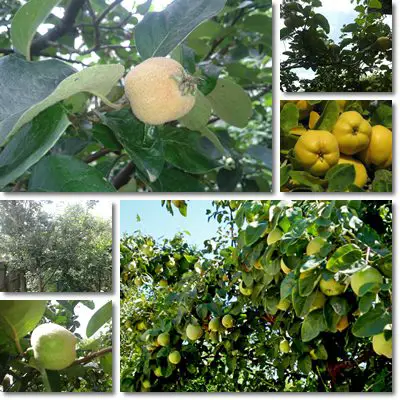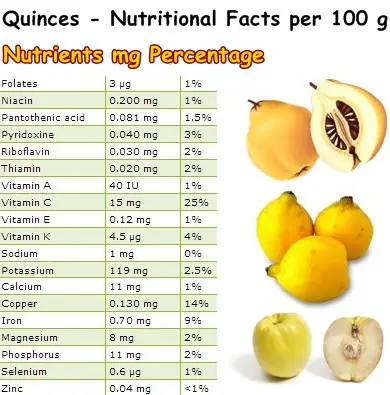The quince (Cydonia oblonga) is the fruit of the tree with the same name. In the past quinces were a very popular fruit, however nowadays they have almost disappeared from our diet, despite their wide availability which allows them to be cultivated in temperate and warm temperate climates around the world. This is unfortunate because the fruits are not only nutritious, but also hold important medicinal properties.
Quinces are related to apples and pears as well as almonds. They are not very juicy, but have a unique flavor profile and a pleasant tartness to them. Quinces are best harvested in late autumn when they turn a deep golden colour and lose some of their white fuzz while acquiring an amazing fruity perfume.
Quinces have valuable antioxidant properties and are moderately nutritious fruit. For example, they are highly recommended for people suffering from gastric ulcers. Quince juice is a famous tonic, antiseptic, analeptic, with amazing restorative and stimulating properties, as well as astringent and diuretic. It is thus recommended for a variety of medical conditions that range from anemia, cardiovascular and respiratory diseases such as asthma to digestive discomfort.

What is a quince?
A quince is a golden fruit that grows on a small tree. It is believed to be older than apples and belongs to the same family as apples, pears, loquats and almonds. It looks somewhat like a large-bodied pear, but with the texture of an unripe fruit and an astringency to it that gives you a dry mouth just like when eating sapodilla.
There are a lot of myths and half-truths surrounding quinces, such as the story that you can’t eat quinces raw or the fabrication that the quince seeds are good for you. Given that it’s such a scarce fruit, the confusion is understandable. But as someone who has grown among quince trees all my life and eats their fruit every autumn and winter, I can tell you what’s really the deal with quinces.
What does a quince look like?
Quinces look like large-bodied, misshaped pears or a sort of combination of pear and apple, plump and somewhat bumpy. The fruit has also been described as looking like a bulky lemon. Quinces start out as beautiful pink-blushed blossoms with silky-soft petals and slowly grow into little, round, bumpy, green apple lookalikes. The unripe, green fruit is covered in a thick layer of pale, dust-colored fuzz which is outgrown.
As it ripens, the color changes to a beautiful golden yellow. Quinces have a very thin, golden skin and a tough, slightly gritty, perfumed, pale yellow flesh. In the center are several brown seeds that look like apple pips. Quince seeds are edible, but best not eaten.
See also: Can You Eat Quince Raw?
What do quinces taste and smell like?
Ripe quinces are golden yellow in color and maintain a tough, crisp, slightly gritty flesh, reminiscent of that of pears. They are astringent to the taste, with a unique quince flavor and moderately strong perfume. Unripe quinces can be too tart and tough to eat raw. But ripe ones are perfectly edible, although you need a good set of teeth for it as the fruit does not grow soft. Despite having a high water content (83.8% water), quince seem to dry out the mouth.
This is because of astringent tannins present in the fruit. Leaving the fruit to withstand the first frosts or storing them at room temperature to ripen could help reduce the dry mouth sensation. Other foods with similar mouth-puckering effects are persimmons, chokeberries or aronia berries, blackberries, cranberries and walnuts, pecans, herbal teas and more.

Quince harvesting, cooking tips and recipe ideas
Quinces are usually harvested at the end of autumn, before the first frost sets in. If still unripe or not ready to eat, they can be kept at room temperature for over a week and will ripen by themselves. The fruit can be cooked like apples or pears. Personally, I find baked quinces absolutely exquisite, but they can be stewed and made into a fruit sauce, added to tarts, made into marmalade or the most delicious jam you’ve ever tasted.
The seeds are best discarded because they contain a harmful element that could become toxic following digestion. Problems arise if large amounts of seeds are ingested, but intake may vary from person to person. In any case, best not eat quince seeds.
Traditional uses of quinces
In Iran, Pakistan and Afghanistan quince seeds were used as a remedy against rashes, ulcers, pneumonia, vocal cord and intestinal problems. Both the juice and the pulp of the quince were boiled or baked and used as a traditional antiemetic remedy that helped prevent and alleviate vomiting and nausea. It’s now believed that the tartness and tannin content of quinces is what makes them useful for relieving nausea.
Quinces, along with apples, were also one of the few sources of vitamin C available throughout winter for people from temperate regions, helping prevent scurvy and other vitamin C deficiency symptoms.
What are quinces good for?
Regular intake can contribute to the following benefits:
Good to eat with digestive issues
Eating quinces on a regular basis is good for digestion. The fruit appears to have a soothing effect on the stomach and is said to help with stomach ulcers and colitis. Some attribute the digestive benefits to antioxidants in quinces (flavonoids such as quercetin, chlorogenic acid and tannins), others to the good pectin content of the fruit, pectin being a type of dietary fiber that helps bind some fruits into jam.
However, because there are at least six known natural acids in the fruit juice which may have an irritating effect on the stomach lining, some experts recommend avoiding the raw fruit and only eating cooked quinces if you have gastritis.
Benefits for lowering cholesterol
Eating quinces helps reduce cholesterol levels in the blood. This effect is primarily a result of the fiber content of quinces (1.9 g of dietary fiber/100 g of fruit), a lot of which is pectin. A healthy fiber intake counteracts the absorption of too much fat from food, resulting in lower total cholesterol and LDL cholesterol levels.
Other cardiovascular benefits
Quinces contain small amounts of potassium (197 mg of potassium/100 g) which contributes to lowering high blood pressure by regulating fluids and counteracting the effects of too much dietary sodium. Moreover, the fruit contains significant amounts of vitamin C (15 mg of ascorbic acid/100g of quince) which plays an important role in preventing fats oxidation and coronary artery disease, reducing the risk of cardiovascular events in high-risk individuals.
Quinces and constipation and diarrhea
Because they contain 1.9 g of dietary fiber per 100 g, quinces are a great way of relieving constipation naturally. And because a lot of that fiber is pectin, eating quinces can help relieve diarrhea as well. You can eat quinces both raw and cooked for constipation and diarrhea. Moreover, the raw fruit is astringent thanks to its tannin content and can further help bind loose stools. However, some people are more sensitive to the tannins in the fruit and eating quinces, especially those that are not yet ripe enough and make your mouth really dry, can either cause a bit of constipation or worsen an existing constipation.

Good for hemorrhoids
Quinces are a good food to eat for hemorrhoids. The good fiber content of the fruit makes it a good food to eat for hemorrhoids. By relieving constipation naturally and improving transit time, quinces help you achieve soft easy stools that are easy to pass, minimizing hemorrhoids symptoms.
Benefits for weight management
Ladies, pay attention: a decent intake of dietary fiber is the key to successful weight loss and a dreamy waistline. So eating quinces can help you have a steady weight and even lose weight, provided the fruit is integrated in an overall balanced, varied and clean diet. Quinces are also low in calories and contain only 57 kcal/100 g.
Rich in antioxidants
Quinces are currently the focus of scientific research because of their generous phytochemical and flavonoid content. They contain important antioxidant elements and exhibit significant anti-inflammatory activity, studies hoping to pave the way for a number of novelty medical uses for the fruit. Antioxidants are potent natural compounds that inhibit and reverse the activity of harmful reactive oxygen molecules called free radicals which are responsible for premature aging and DNA and cell damage.
Other benefits
Quinces are further good for you because they have a mild tonic and restorative action thanks to small amounts of vitamins B1, B2, B3, B6, calcium and iron, as seen in the nutritional table above, and a good carbohydrate content of 15.3 g of carbs and 1.9 g of sugar for every 100 g of fruit. They contain less than 0.1% fat, most of which is unsaturated.
Conclusion
Originally, quince trees were cultivated in Iran, Pakistan, Afghanistan, Uzbekistan, but have successfully been introduced to most East European countries. They have accommodated so well that nowadays they can be found throughout North and South America, Europe and Asia, especially in rocky areas and highlands. Most quince trees grow to a height of around 5-8 meters and are very resilient, easily withstanding temperatures below -15°C and lower.
In the Balkans, they are very often eaten raw or made into delicious jams due to their high pectin levels which allow for the fruit sauce to bind well. In Albania, Romania, Bulgaria or Hungary, they are often stored in cellars and baked during winter along with apples, while in Iran they are stewed or added to soups. In more modern cuisines, they are either used in tarts or pies or as a sweet-tart side dish to roast meat. Quinces are also used to make a sort of sweet brandy. All in all, they make a wonderful addition to any diet as they are flavorful, versatile and moderately nutritious. Most important, they can provide relief for a considerable number of mild to severe medical conditions due to their impressive curative properties and medicinal effects.
